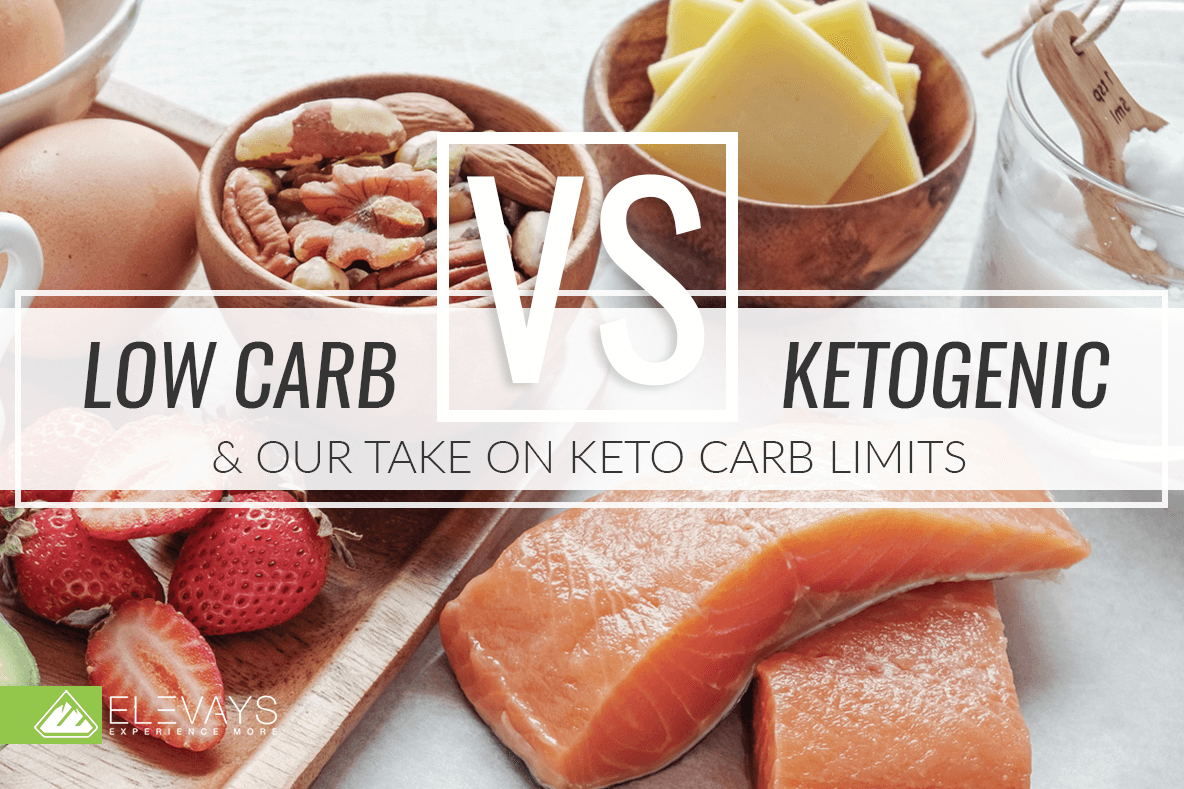Keto’s great. Science and experience have proven it. But sometimes keto’s hard. Luckily, there just may be a happy solution: keto carb cycling (sometimes referred to as the cyclical ketogenic diet), a time when you can actually raise your keto carb limit and still get your ketosis benefits.
You see, countless scientific studies have shown us the immense, and honestly quite varied, health benefits that come from the high-fat ketogenic diet. It can improve epilepsy, diabetes, heart disease, acne, brain trauma, metabolism, energy, and more (for a rundown of more benefits, check out our post on keto results).
But following the keto diet can feel difficult and even unsustainable for two big reasons:
TRUTH BOMB:
You’re
Already killing it!
If You Were More Consistent With Your Wellness Routine, You’d Be Unstoppable.
- We’re humans. It can be hard to follow a restrictive high-fat diet for a long time. We have food cravings, many of which are carb-related. We go out to eat with friends and family. We eat dinner at other people’s homes. Following your strict keto macro ratio can feel impossible on some days, and you crave a keto cheat day.
- You may not feel 100% great all the time with consistently low carbs. Some people feel like a million bucks; others not so much. Each body is different and each lifestyle is different – that means extremely low carb eating day in and day out may not leave everyone feeling as healthy as possible.
These two frustrating problems lead many people to consider cheating on keto. Then they do cheat. Then they get out of ketosis and out of the habit. Then they give up. And all that keto effort goes down the drain.
So lots of people are searching for solutions and want to know how/if they can have a cheat day on keto in a healthy, sustainable way. Enter keto carb cycling, a method that allows you to be more flexible with your macronutrient intake in an orderly and nutritious way.
I’m going to introduce you to everything you need to know about this system of eating that allows you to benefit from diet-induced ketosis most of the time, while also feeding your body the carbohydrates its needing/wanting. And you can do so without squashing the whole keto plan and ketosis health results.
Think of it as your healthy, controlled keto cheat day.
Keto Basics
To understand this more flexible form of keto macro percentages while you’re doing a cyclical keto diet, we first need to make sure we understand the basics of the regular, regimented keto diet.
Keto Percentages
Throughout this article on adjusting your keto carb limit – and really through any sort of keto article – there will be a lot of talk about keto percentages, which may be called your keto ratio, keto macro ratio, etc. Essentially, this is just the breakdown of your macronutrients (also called macros):
- Fat
- Protein
- Carbs
Another thing to keep in mind is the difference between carbs and net carbs on keto. If you want to know what is considered a low carb daily intake on keto, the general rule of thumb is 20 to 30 grams of net carbs a day. If you’re thinking, “What are net carbs?” It’s simple. Net carbs are what’s left after you subtract the fiber from the total carbs.
So, if a food has 9 grams of total carbs but there’s 2 grams of fiber the net carbs are 7 grams. This is helpful to know because net carbs are really what you want to look at when calculating your keto carb limit.
Now, when it comes to macros in a standard keto diet, the keto percentages will look something like this:
- Fat – around 65% or higher
- Protein – around 30% (sometimes less)
- Carb – around 5% (give or take a bit)
There’s definitely room for changes. Some eat more fat, some eat more protein. And obviously from day-to-day it will adjust a little. But as you can see, your carb intake is so incredibly low – this is what can make long term keto so hard to sustain.
When we move into the keto carb cycling system I’m about to explain, these percentages change quite a bit.
Low Carb vs. Keto
Low carb dieting isn’t new – the Atkins diet was wildly popular in the 90s and into the early 2000s, but let’s be clear: there is a big difference between low carb vs. keto.
While both follow a macronutrient breakdown that has low carbs, keto’s emphasis is high fat and moderate protein to achieve the state of ketosis, a very particular metabolic state where you burn fat for fuel.
Since the goal is to stay in ketosis, there is typically very little budge room when it comes to cheat days or a sweet potato craving (much less a brownie craving!).
But the body is flexible. It can come in and out of ketosis (this becomes easier the longer you’ve been doing it), so there’s another option on the table.
What Is Keto Carb Cycling?
At its core, keto carb cycling is simple: it allows you to eat more carbs for a specific day or two in order to improve your results on the keto diet.
Your keto carb limit goes up for a short, designated period of time. Then you go back to your regular keto percentages.
By doing this cycle, you are moving your body in and out of the states of ketosis. But it’s in a controlled way.
Sometimes those in the cyclical keto diet community will call your high carb days, “carb refeed” days. And that paints a good picture of what you’re doing… you’re “refeeding” your body with some healthy carbs, then you’re moving back to your regular keto.
In a way, this low carb/high carb structure mimics a feast or famine model which has been shown to offer its own set of benefits.
- You’re in “famine” while following your typical keto carb limit (though you’re getting plenty of calories).
- Then you’re in “feast” while upping your keto carb limit. The cycle repeats.
The idea of carb cycling around any sort of diet is not new.
Lots of active people have carb cycled, eating more carbs near their workout or eating more carbs on days where they know they are going to train harder. This ups the glycogen found in your muscles, so you can push harder and build muscle faster. Then they’d switch to low carb so their bodies would mostly burn fat and improve insulin sensitivity (1, 2, 3, 4, 5)
Ultimately, in order for your cyclical keto diet to be a real keto diet, you will have to return to that high fat keto ratio that brings you into ketosis. Otherwise you’re just alternating between high and low carbs with no rhyme or reason.
Reasons for Keto Carb Cycling
So why bother adjusting your keto carb limit from time to time? Here are some of the reasons why keto carb cycling may be just right for you (6, 7, 8, 9, 10, 11, 12).
- Ease: As we’ve talked about, the typical keto ratio is challenging for the long periods of time, and people want to find a way to get in some cheat days on keto. When you know you’re going to enjoy a delicious fruity smoothie on Saturday morning, and some tasty sweet potato oven fries on Saturday night, you’re going to be less tempted to cheat on your designated “strict keto” days.
- Boosted micronutrients/fiber: A common issue with keto is the lack of fruit and vegetable variety can lead to certain vitamin and mineral deficiencies as well as low fiber. Having the opportunity to add in some extra veggies and fruit can make world of difference in this department. (As can keto supplements – learn more about those here!)
- Improved energy: One of the reasons people try the keto diet is to gain energy. But everyone is different. Some people find that the consistently low keto carb limit makes them feel exhausted. Including days with higher carbs can give you the boost you’re looking for.
- Balanced hormones: This one is true for women especially. Long-term keto macro percentages with very little carbs can potentially end up messing with your thyroid hormones – leading to a whole chain reaction of hormonal issues. For men, it can help with testosterone.
- Feast/Famine: Research has shown this model can help people burn the proper energy source when needed (instead of always going straight to sugar/carbs) and improve the immune system, gut, insulin sensitivity, inflammation, hormones, cellular communication, and more.
- Speed Up Metabolism: Like increased energy, many people go on the keto diet to lose weight, but some people’s metabolism does not respond well to the lower keto carb limit. It may actually slow down your metabolism. Having cycles with a higher carbohydrate keto ratio can help find a nice balance.
- Increase Muscle: Cyclical keto macro percentages can actually increase growth hormone and IGF-1, which makes muscle building easier. Plus, increased carbs can actually improve gym performance and maintain proper BCAAs. The increased testosterone will help as well. Finally, it’s also important that athletes have some glycogen stores so that they can utilize that to fuel their intense sessions vs. relying on muscle protein.
In order to get the benefits of ketosis on the days when you’re following your standard keto diet…and to get these new benefits of your high carb days, you need to treat this keto cheat day correctly – not like a full-on, go “hog wild” cheat day…
Is This a Full on Keto Cheat Day?
At this point you may be thinking how great this is. You can eat like a health nut during the week and then go crazy on the weekends with chips and pancakes and ice cream… and never have to face the health consequences.
Not so.
I know I’ve talked about the fact that upping your keto carb limit will give you the feeling of a keto cheat day. But I want to clarify what I mean by that.
We’re not talking about going crazy on processed carbs here. A slab of cheesecake isn’t carb cycling. A can of soda and candy bar isn’t carb cycling. You are still focusing on healthy, whole, unprocessed foods that provide dense nutrients.
You’re going to need to choose high fiber and plant-based carbs that have plenty of vitamins and minerals. Here are the types of foods you can include when your carbohydrate keto ratio is going up a bit for the day:
- Starchy or “sugary” veggies like sweet potato, peas, carrots or squash
- Superfood smoothies with more berries or other fruit than normal
- High-value, unrefined grains like quinoa and lentils
- Beans
These are more complex carbohydrates, which means they take longer to digest. This process keeps insulin steadier, which is so incredibly important since a foundational concept of keto is stabilized blood sugar.
Carb cycling gives you a chance to enjoy those (healthy) carby foods you love and find fulfilling, but it’s done in such a way that you’re not compromising your health. In fact, it can actually help you enhance your results.
But here’s what you will not be eating on your ketogenic diet cheat day (simple carbohydrates):
- Refined carbs like white bread and white sugar
- Fruit juice, sport-ade beverages, or other sugary drinks
- Cookies, cake, ice cream, etc.
- High fructose corn syrup or sweeteners
A keto cheat day is not about pigging out and stuffing your face with all the processed, high-sugar foods you could ever want. Remember, you’re choosing to eat this way because you want your body to be healthy, you want your energy to be higher, you want your insulin to be balanced, etc.
Sugar frenzy ruins all those plans.
That does not mean you can’t enjoy your keto cheat day. On your higher carb days, you can still have tasty things like quinoa pasta with a meat and veggie sauce, a baked apple with cinnamon, some tacos with turkey meat, black beans and pineapple slaw, or even some dark chocolate with almond butter.
These are examples of decadent, delicious, satisfying dishes that will keep you satisfied enough to stay on track during your week.
How to Set Up Keto Carb Cycling for Success
If you’d like to try adjusting your keto carb limit to create a healthy keto cheat day, you’re probably wondering how to do so successfully.
In all honestly, there’s not one particular way to adjust your keto percentages while carb cycling – you get options!
The standard way to perform keto carb cycling will involve 5 or 6 full days at the regular keto macro ratio and will then add 1 or 2 days of higher carb.
The reason it’s so popular is twofold:
- It falls into a week vs. weekend pattern. The weekend is often when the family wants to try a new restaurant, when you head to friend’s house for dinner, or when you’re tired and want to have a relaxing day. That’s when cheating on keto becomes such an issue. Having some planned carb freedom on the weekends is a recipe for success.
- It’s consistent. You know you’re getting at least 5 full days in ketosis each week without fail.
But that does not mean it’s the only cyclical ketogenic split. Here are a few examples of how other people set it up (7, 11, 13, 14):
- Some will up their keto carb limit for two or three meals per week, spread out at different times
- Some will modify the weekend plan by starting back to their stand keto diet on Sunday night and getting off their standard keto diet on Friday evening
- Some will do regular keto meals 4 or 5 days a week, 1 to 2 days of higher carb, and 1 day of intermittent fasting
- Some split-up high carb days of the week – a common one is Thursday and Sunday
- Some will do 2 weeks of a standard keto macro ratio and then do 3 to 4 days of high carb intake
- Some will stick to the keto diet everyday but eat a carby meal around 30 minutes before they hit the gym to train
- Some will follow a more advanced phase of 16 to 20 hours of intermittent fasting from protein and carbs, followed by 1 day of higher carbs and higher protein, followed by 1 day of intermittent fasting from carbs and protein (this is definitely not giving you the ease we’re aiming for with keto carb cycling/a keto cheat day, but it is still an option)
- Some will stay in ketosis for a month and then add in a higher carb meal period
- Some will keep it entirely intuitive: when you feel like you need a higher carb day, you give it to yourself. This route is only for people that are extremely disciplined or they’ve been on keto for a while. You can easily slip into a “free for all” with this plan.
Arguably the weekend vs. week pattern is going to give you the easiest form of a keto cheat day while keeping the structure that most people need to stick with any kind of nutrition plan. With the weekend vs. week pattern you can enjoy more foods in social settings while you’re not working. But you need to find what works best for your body and your living schedule.
Cycling Tip: Some people like to have a good workout the morning after their carb refeeding day to help reduce their glycogen stores and get into ketosis a bit faster.
But How Many Carbs Will You Really Be Eating?
Just like there’s variation when it comes to which days will be your keto cheat day, there’s also variation in just how many carbs you are eating during your keto cheat day/s.
Here are a few examples of how you can do it:
- First day: 70% carbs, 15% protein, 15% fat; Second day: 60% carbs, 25% protein, 15% fats; rest of the week: your regular keto percentages (15)
- Some stick to 60% to 80% carbs on their high carb days, 15% to 35% protein, and 5% to 10% fat (essentially, it’s the exactly opposite of a typical keto carb limit)
- Be a little more free/intuitive. Stick to your regular keto meals, but toss in a side of quinoa or have some fresh strawberries with your normal breakfast.
In the same way you’re going to need to take some time to find the keto carb cycling schedule that works for you, you also need to figure out what type of macronutrient breakdown works for you on your higher carb days. Be a bit patient with it.
This whole process takes a little experimentation, so stay alert. Maybe even keep a journal of how you’ve felt, your weight, your energy levels, your workouts, etc. as you discover your optimal carb cycling rhythm.
But no matter how you set it up, you will also need to have far more keto days than cheat days on keto. You still want to spend the majority of your time in ketosis. Otherwise those health benefits simply won’t be there.
If you really want to get more precise with how many carbs to start with, you can use a ketosis calculator. It will tell you the ideal amount of carbs, protein and fat that you need to be eating on your “strict keto days” to get the full benefits of being in ketosis. Once you know what those numbers are you can adjust your macros on your keto carb cycling days so that it’s more flexible.
Who Shouldn’t Follow Keto Carb Cycling
While many people will find adjusting your keto carb limit, and therefore giving yourself a nice keto cheat day or two, is a really sustainable and healthy way to live, that doesn’t mean it’s for everyone.
Both children and pregnant/nursing women should not follow this model unless under the close supervision of their doctor. Both groups of people tend to need more consistency and more carbs.
Then there’s those who simply do not feel good on the diet. To know if this is you, you will have to give the process a good two or three weeks. That’s because you probably will feel some initial adjustment side effects like fatigue, carb cravings, weak workouts, irritability, or insomnia, etc.
Those should go away within a week or two – if they linger, it just may not be the perfect fit. Your age, genes, activity level, gender, etc. may not like that type of eating. Be intuitive and listen to your body (6).
Upping Your Keto Carb Limit
If you’ve been wanting to follow the keto diet, but have struggled with the restrictiveness, lifting up your keto carb limit on the weekends (or whichever days you choose) may be the solution that gets you there.
Hopefully adjusting your keto ratio in this way will help you stick to your keto diet for much longer. It will keep you compliant on your standard keto days, and keep you healthy (yet completely satisfied) on your ketogenic diet cheat day.
Now tell me about your keto plans. Are you on the keto diet? Have you tried any sort of keto carb cycling? If so, how do you alter your keto carb limit? Do you choose certain days? What are your favorite ways to create a keto cheat day that still fuels your body? Share your tips, tricks, and experiences in a comment below.
Sources:
- Ivy, J. L. (1998). Glycogen resynthesis after exercise: effect of carbohydrate intake. International journal of sports medicine, 19(S 2), S142-S145.
- Børsheim, E., Cree, M. G., Tipton, K. D., Elliott, T. A., Aarsland, A., & Wolfe, R. R. (2004). Effect of carbohydrate intake on net muscle protein synthesis during recovery from resistance exercise. Journal of applied physiology, 96(2), 674-678.
- Kunces, L., Volk, B., Freidenreich, D., Saenz, C., Fernandez, M. L., Maresh, C., & Volek, J. (2014). Effect of a very low carbohydrate diet followed by incremental increases in carbohydrate on respiratory exchange ratio (LB444). The FASEB Journal, 28(1 Supplement), LB444.
- Gower, B. A., & Goss, A. M. (2014). A Lower-Carbohydrate, Higher-Fat Diet Reduces Abdominal and Intermuscular Fat and Increases Insulin Sensitivity in Adults at Risk of Type 2 Diabetes–3. The Journal of nutrition, 145(1), 177S-183S.
- Healthline, (2017). What is Carb Cycling and How Does It Work? Retrieved from: https://www.healthline.com/nutrition/carb-cycling-101#section2
- Dr. Axe, (2018). Carb Cycling Diet Plan Benefits & Tips to Maintain Healthy Weight. Retrieved from: https://draxe.com/carb-cycling-diet/
- Dr. Jockers, (2018). How to Follow a Cyclic Ketogenic Diet. Retrieved from: https://drjockers.com/follow-cyclic-ketogenic-diet/
- Kose, E., Guzel, O., Demir, K., & Arslan, N. (2017). Changes of thyroid hormonal status in patients receiving ketogenic diet due to intractable epilepsy. Journal of Pediatric Endocrinology and Metabolism, 30(4), 411-416.
- Chouinard-Watkins, R., & Plourde, M. (2014). Fatty acid metabolism in carriers of apolipoprotein E epsilon 4 allele: is it contributing to higher risk of cognitive decline and coronary heart disease?. Nutrients, 6(10), 4452-4471.
- Sebokova, E., Garg, M. L., Wierzbicki, A., Thomson, A. B., & Clandinin, M. T. (1990). Alteration of the lipid composition of rat testicular plasma membranes by dietary (n-3) fatty acids changes the responsiveness of Leydig cells and testosterone synthesis. The Journal of nutrition, 120(6), 610-618.
- 11.Bodybuilding.com, (2015). Cyclical Ketogenic Diet. Retrieved from: https://www.bodybuilding.com/content/cyclical-ketogenic-diet.html
- Manninen, A. H. (2004). Metabolic effects of the very-low-carbohydrate diets: misunderstood” villains” of human metabolism. Journal of the International Society of Sports Nutrition, 1(2), 7.
- Dr. Jockers, (2018). Burn Fat with a Cyclical Ketogenic Diet. Retrieved from: https://drjockers.com/cyclical-ketogenic-diet/
- Ketovale, (2017). Carb Ups on Keto Diet (Cyclical Ketosis). Retrieved from: https://www.ketovale.com/carb-ups-and-cyclical-ketogenic-diet/
- Ruled. Me. (2018). What To Eat on a Cyclical Ketogenic Diet. Retrieved from: https://www.ruled.me/eat-cyclical-ketogenic-diet/









This is a great introductions to keto and it’s ratios. Thanks for sharing 🙂
Hi Sarah! We’re so glad you found it helpful!
This is a very insightful article. Especially now that I am starting on keto. Thanks for sharing!
We’re so glad you found it helpful! We also have an ultimate guide to keto at elevays.com/keto that would be a great resource as you start your keto journey 🙂
Very informative article! I definitely learned a lot from this! I really thought low carb and keto are just the same diets before. Thanks for posting this!
I’m so glad it was helpful for you! Thank you for reading!